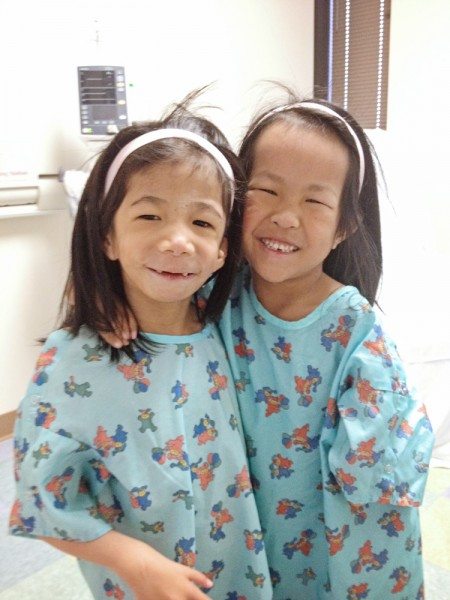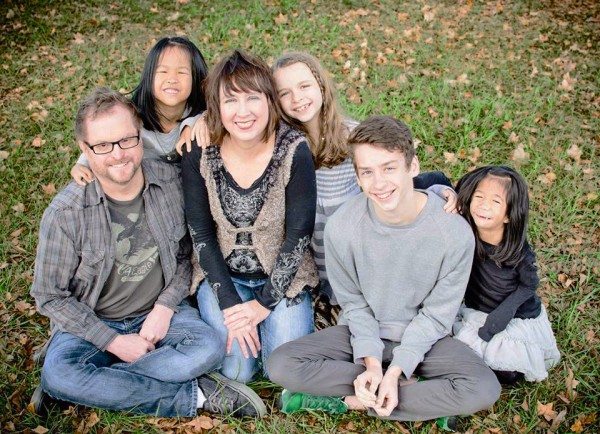We always knew there were unknowns, as all adoptive parents do. But the moment we saw their faces we knew they were ours. This is important to always remember. Most of us who adopt realize that the medical records we receive are not always accurate or trustworthy. But sometimes, you just don’t know the right questions to ask.
We have two daughters who are deaf and in both cases we did not know this until each was home for a year. In order not to be too confusing, I will begin with Madelyn, the first child we adopted. We adopted Madelyn in 2011, when she was almost four. She was born with Duane Radial Ray Syndrome, which is a genetic syndrome that caused her to have bilateral radial aplasia, and strabismus. (This is one of the TARS syndromes, but she did not have any heart or kidney issues.)
We took Madelyn for her preschool screening, and she passed her hearing test. The following year she failed her kindergarten screening in her left ear. We went to the ENT and had an audiologist test her. She was found to have profound hearing loss in her left ear. This type of hearing loss is unilateral sensorineural loss. The doctor said she would be fine and that she would just learn to live with it. This is important, since this was the first lesson I learned as a parent of deaf child. Don’t take this for an answer!
Fast forward to 2013, we went back to China to adopt Madelyn’s best friend from foster care, Ashton. Ashton was almost six at the time. Ashton was also born with a rare genetic syndrome. Nager Syndrome is mainly a craniofacial syndrome but also causes limb differences. We were originally told that Ashton had a cleft palate and underdeveloped jaw, arms that would not straighten at her elbows and small ears. We tried to research the best we could and did realize before we went that she may have a syndrome related to the Pierre Robin sequence.
When she came home, she started kindergarten. We did not attempt a hearing test because the audiologist said Ashton’s test would not be accurate because of the language issue. So we waited. Three months after she was home, I drove five hours to Cincinnati to be told by a doctor that she did not have a cleft palate, but a short palate and he did not think it could be repaired. First of all, I did not know what a short palate was? Secondly, I was thinking, so then what do we do? She was not really talking and something did seem wrong with her hearing. So I came home, frustrated. What did I do? Got on Facebook. I found groups that told me that a short palate could be repaired.
Her hearing still did not seem right, but we were convinced from doctors that is was a palate issue. No one mentioned hearing.
The answer to our prayers finally came with a visit to the craniofacial clinic at Scottish Rite in Atlanta. Prior to going, I emailed the director and he immediately emailed me back. He knew all about Nager Syndrome, which no one did, and we set an appointment. Four surgeries between September 2014 and April 2015 included a hearing test while sedated, palate fix, jaw distraction, cholesteatoma removal (benign cyst in ear that causes hearing loss) and BAHA surgery (bone anchored hearing aid with magnet). Today she is a completely different child.
After the hearing test (ABR) during one of her surgeries, we learned she was deaf in her right ear, but had a large cholesteatoma in her left ear. This was removed during a future surgery and her ear canal, etc. reconstructed. Finally after all of the surgeries, we were able to grasp her hearing loss, which was basically moderate to severe in both ears.
All of this to say, hearing is a big issue that kept being ignored. So, I learned, if you think hearing is an issue, it probably is!
The final surgery was for both girls to get BAHAs. Yes, both Madelyn and Ashton were candidates. Through research to find out if our insurance would cover Ashton’s surgery, I read that our insurance covered unilateral sensorineural hearing loss. I thought to myself, that is the type Madelyn has. I wondered why her doctor did not mention it? So, I talked to Ashton’s doctor and he said the BAHA would be great for Madelyn! It was concerning that the other doctor did not say anything. I later learned that some doctors still don’t recommend hearing aids for unilateral hearing loss.

Our journey still continues. Ashton has made great strides now that she has her BAHA. Realize, she did not hear for her first seven years of life, so she has a long way to go. Her expressive and receptive vocabulary is that of a three year old. We have chosen auditory-verbal speech therapy for her. This helps her learn to speak from listening/hearing not from reading lips or signing. She has speech therapy at school and with a private therapist twice a month. Her palate is still also an issue since there are still two holes in the palate. She will need surgery again in the next couple of years. Ashton is currently in first grade because she had to repeat kindergarten. She has an IEP, and we are always making sure she has the services she needs in school.
Madelyn has also benefited greatly from her BAHA. She can now “hear” on both sides and it really helps her in the classroom with all of the background noise present.
I’d like to conclude with a few things that may help you along the way:
1. Question everything and don’t hesitate to get a second opinion.
2. Visit a well-respected pediatric ENT if your child has had ear infections, so they can truly assess the damage. Looking back, Ashton had several ear infections that were treated and came back. The pediatrician couldn’t see into her ears properly, so we just treated it. It wasn’t until her surgery that we found out about the cholesteatoma. Since then, I have met many adoptive parents with this issue.
3. Find someone to help you learn and advocate for you. We found a non-profit organization in North Carolina called Beginnings whose purpose is to help families with children who are deaf. A parent educator came to our home and taught us about the different ways to communicate and more. She helped us find an auditory-verbal speech therapist, when we decided to have our daughters communicate with speech. She also helps us with IEP meetings at ol and more.
4. Look at all the options for hearing aids. There are so many options.
5. Get a good private speech therapist that will help you navigate the ways to communicate with your child and how you would like your child to communicate with you and others.
6. Join support groups on Facebook.
7. Take a deep breath. Realize that everyone’s experience adopting a deaf child is different and that everyone chooses to communicate differently with their child

Our girls our amazing survivors! They work really hard and love everyone around them. We are so blessed to have them in our family!
– guest post by Amy

























We are fighting this battle right now. We were told Annas unilateral hearing loss would not be an issue (she has microtia). However she is now 5 and not talking. She was severely neglected for 2 years China so all the Specialist have contributed the lack of speech to that. We have an appointment next week with the ENT in Chapel hill. My theory is the lack of hearing on one side could be a big part of the issue. I am going to push for the implanted hearing aid for the side without an ear and a permanent tube in the other ear where we have been told she has chronic fluid. She is also tongue tied. Which no one seems to think is a problem. But how can you make the correct sounds to make words if your tongue is totally attached to the floor of your mouth. I agree……ask questions and advocate for your child or they will fall behind before the professionals address some issues. We had to see 5 eye doctors before we found one who could get a good exam and fit Anna with glasses. Another issue which I am sure has not helped her developmental delays. Thanks for the info on Atlanta. I may need it if I get nowhere in Chapel Hill.